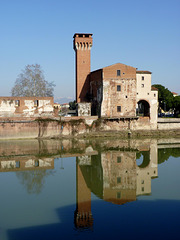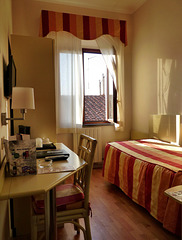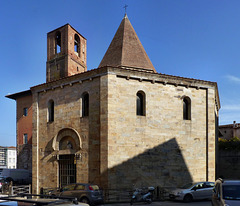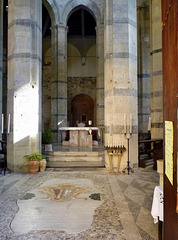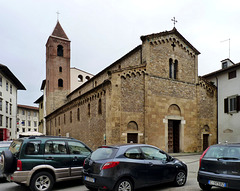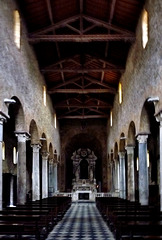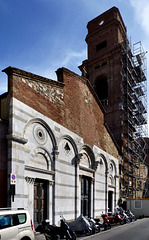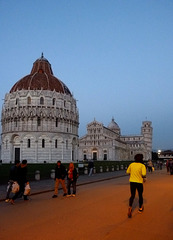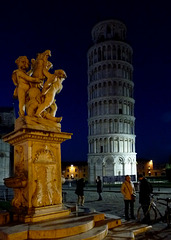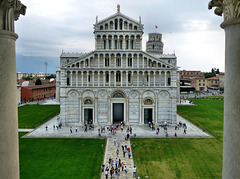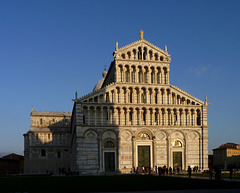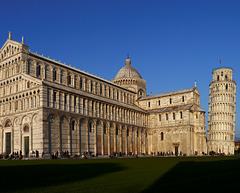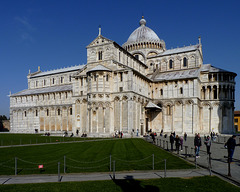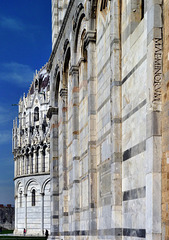
Pisa, Lucca and Pistoia
Pisa - Leaning Tower
| |
|
|
|
The Leaning Tower is the main tourist attraction in Pisa. Zillions of photos are taken here each week.
The construction of the tower started exactly on August 14, 1173. Architects were either Bonanno Pisano, who created the bronze doors (previous uploads) or Diotisalvi, the architect of the Baptistery.
The tower's tilt began already during the construction, caused by an inadequate foundation on ground too soft to properly support the structure's weight. Due to wars, Pisa waged against Genoa, Lucca and Florence, it was on halt for a century, but was continued and completed in 1372.
A long discussion started in the 20th century, how to prevent the tower from toppling. 800 tonnes of lead counterweights got installed. In 1989, after a medieval tower in Pavia had collapsed, the Leaning Tower was closed to the public. Engineers were able to straighten the tower by 45 cms and the tower was opened to the public again end of 2001.
In 2008, after the removal of 70 tons of ground, engineers announced that the Tower had been stabilized. They stated it would be stable for at least 200 years.
Pisa - Torre Guelfa
| |
|
|
|
The tower, built around 1406 when the Florentines ruled Pisa, was part of the old "cittadella". It was named "Torre Guelfa" as an other, older tower in Pisa was named "Torre Ghibellina". In 1944 the Torre Guelfa was completely destroyed the bombings of World War II. It got rebuilt in 1956.
Between tree and tower the snow capped mountains of the Apennines are visible on the horizon.
Pisa - Chiesa del Santo Sepolcro
| |
|
Seen on the southern banks of the Arno river is the roof of the octagonal "Church of the Holy Sepulchre" was built for the Knights Hospitaller (aka "Order of the Knights of Saint John") in the early 12th century. It was designed by Diotisalvi, who later designed the Baptistery of Pisa Cathedral.
Pisa - Chiesa del Santo Sepolcro
| |
|
|
Already existing in 1113, the octagonal "Church of the Holy Sepulchre" was built for the Knights Hospitaller (aka "Order of the Knights of Saint John"). It was designed by Diotisalvi, who later designed the Baptistery of Pisa Cathedral. His name is inscribed on a wall of the tower ""Huius OPERIS FABRICATOR DeuTESALVET nominatur».
Pisa - Hotel Bologna
Pisa - Chiesa del Santo Sepolcro
| |
|
|
|
Already existing in 1113, the octagonal "Church of the Holy Sepulchre" was built for the Knights Hospitaller (aka "Order of the Knights of Saint John"). It was designed by Diotisalvi, who later designed the Baptistery of Pisa Cathedral. His name is inscribed on a wall of the tower ""Huius OPERIS FABRICATOR DeuTESALVET nominatur».
Pisa - Chiesa del Santo Sepolcro
| |
|
Already existing in 1113, the octagonal "Church of the Holy Sepulchre" was built for the Knights Hospitaller (aka "Order of the Knights of Saint John"). It was designed by Diotisalvi, who later designed the Baptistery of Pisa Cathedral. His name is inscribed on a wall of the tower ""Huius OPERIS FABRICATOR DeuTESALVET nominatur».
The church was locked, but I found a window. Inside around the altar is a rotunda out of eight pillars - and a kind of ambulatory around the center. This interior rotunda is "generic" for churches of the "Holy Sepulchre", eg "Neuvy-Saint-Sépulchre", "Drueggelte", "Northampton"..
Pisa - Chiesa di San Sisto
| |
|
|
|
The "Chiesa di San Sisto" was consecrated in 1133, but it is probably about a century older. The church is dedicated to the martyr San Sisto (aka "Pope Sixtus II"), who was the patron saint of Pisa at that time.
San Sisto´s feast was celebrated on August 6th. On August 6th 1284 the "Battle of Meloria" was fought between the fleets of the Republics of Genoa and Pisa.
Genoa won that battle. More than 10.000 Pisan soldiers got killed - and the decline of the Republic of Pisa began. This was as well the end of Saint Sisto´s career as patron saint of Pisa.
Pisa - Chiesa di San Sisto
| |
|
|
The "Chiesa di San Sisto" was consecrated in 1133, but it is probably about a century older. In the dim light of a late afternoon, the church looks very "basic" with the wooden roof. Some of the capitals are reused Roman ones.
The church is dedicated to the martyr San Sisto (aka "Pope Sixtus II"), who was the patron saint of Pisa at that time.
San Sisto´s feast was celebrated on August 6th. On August 6th 1284 the "Battle of Meloria" was fought between the fleets of the Republics of Genoa and Pisa.
Genoa won that battle. More than 10.000 Pisan soldiers got killed - and the decline of the Republic of Pisa began. This was the end of Saint Sisto´s career as patron saint of Pisa.
Pisa - Chiesa di San Paolo all'Orto
| |
|
The church got erected within the 11th century in a rural, suburban area, that by now is in the center of Pisa. The facade, seen here, dates to the 12th century. Augustinian nuns lived here for centuries, meanwhile the structure is used for cultural events by the University of Pisa.
Pisa - Piazza dei Miracoli
| |
|
|
|
Nightfall in Pisa. Most of the tourist have left the Piazza dei Miracoli already. Now the Pisans take a walk around the Baptistery, the Cathedral and the Leaning Tower.
Pisa - Piazza dei Miracoli
| |
|
|
|
Nightfall in Pisa. Most of the tourist have left the Piazza dei Miracoli already. Now the Pisans take a walk along the Baptistery, the Cathedral and the Leaning Tower.
Pisa - Leaning Tower
| |
|
|
|
The Leaning Tower is the main tourist attraction in Pisa. Zillions of photos are taken here each week.
Some decades again a discussion started, how to prevent the tower from toppling. 800 tonnes of lead counterweights got installed. In 1989, after a medieval tower in Pavia had collapsed, the Leaning Tower was closed to the public. Engineers were able to straighten the tower by 45 cms and the tower was opened to the public again end of 2001.
The engineers returned - and in 2008 they had installed underground cables to the secure the tower. What not many people know, is, that over nighttime, the tower is moved in an upright position. Then all motors holding the cables are switched off. Power consumption is zero - and 1 terawatt of electricity is saved each year.
Here is the tower seen in the upright night-position.
Pisa - Duomo di Santa Maria Assunta
| |
|
|
The construction of the "Duomo" began in 1064 by the architect Busketo, who with this structure set the model for the distinctive Pisan Romanesque style of architecture.
The façade, seen here from the gallery of the baptistry, was built by master Rainaldo. Just like Diotisalvi, who had designed the baptistry he had designed, Reinaldo signed the facade over the center door "Rainaldus prudens operator".
Above the doors there are four rows of open galleries with, on top, statues of Madonna with Child and, on the corners, the Four evangelists.
When the construction of this cathedral started, Pisa was on a height of political (and financial) power. Pisa was an important commercial centre controlling large parts of the Mediterranean merchant fleet and navy.
In 1017 Pisa had militarily supported the Sardinian "Giudicati" (regional kings) to defeat Saracen troops in the north of Sardinia. Between 1030 and 1035, Pisa defeated rival towns in Sicily. In 1051–1052 admiral Jacopo Ciurini conquered Corsica. In 1063 admiral Giovanni Orlando, coming to the aid of the Norman Roger I, took Palermo from the Saracen. The gold treasure taken from the Saracens in Palermo allowed the Pisans to start the building of the cathedral - and all other building of the "Piazza del Duomo".
Pisa - Duomo di Santa Maria Assunta
| |
|
The construction of the "Duomo" began in 1064 by the architect Busketo, who with this structure set the model for the distinctive Pisan Romanesque style of architecture.
The façade was built by master Rainaldo. Just like Diotisalvi, who had designed the baptistry he had designed, Reinaldo signed the facade over the center door "Rainaldus prudens operator".
Above the doors there are four rows of open galleries with, on top, statues of Madonna with Child and, on the corners, the Four evangelists.
When the construction of this cathedral started, Pisa was on a height of political (and financial) power. Pisa was an important commercial centre controlling large parts of the Mediterranean merchant fleet and navy.
In 1017 Pisa had militarily supported the Sardinian "Giudicati" (regional kings) to defeat Saracen troops in the north of Sardinia. Between 1030 and 1035, Pisa defeated rival towns in Sicily. In 1051–1052 admiral Jacopo Ciurini conquered Corsica. In 1063 admiral Giovanni Orlando, coming to the aid of the Norman Roger I, took Palermo from the Saracen. The gold treasure taken from the Saracens in Palermo allowed the Pisans to start the building of the cathedral - and all other building of the "Piazza del Duomo".
Pisa - Duomo di Santa Maria Assunta
| |
|
The construction of the "Duomo" began in 1064 by the architect Busketo, who with this structure set the model for the distinctive Pisan Romanesque style of architecture.
When the construction of this cathedral started, Pisa was on a height of political (and financial) power. Pisa was an important commercial centre controlling large parts of the Mediterranean merchant fleet and navy.
In 1017 Pisa had militarily supported the Sardinian "Giudicati" (regional kings) to defeat Saracen troops in the north of Sardinia. Between 1030 and 1035, Pisa defeated rival towns in Sicily. In 1051–1052 admiral Jacopo Ciurini conquered Corsica. In 1063 admiral Giovanni Orlando, coming to the aid of the Norman Roger I, took Palermo from the Saracen. The gold treasure taken from the Saracens in Palermo allowed the Pisans to start the building of the cathedral - and all other building of the "Piazza del Duomo".
Pisa - Duomo di Santa Maria Assunta
| |
|
The construction of the "Duomo" began in 1064 by the architect Busketo, who with this structure set the model for the distinctive Pisan Romanesque style of architecture.
When the construction of this cathedral started, Pisa was on a height of political (and financial) power. Pisa was an important commercial centre controlling large parts of the Mediterranean merchant fleet and navy.
In 1017 Pisa had militarily supported the Sardinian "Giudicati" (regional kings) to defeat Saracen troops in the north of Sardinia. Between 1030 and 1035, Pisa defeated rival towns in Sicily. In 1051–1052 admiral Jacopo Ciurini conquered Corsica. In 1063 admiral Giovanni Orlando, coming to the aid of the Norman Roger I, took Palermo from the Saracen. The gold treasure taken from the Saracens in Palermo allowed the Pisans to start the building of the cathedral - and all other building of the "Piazza del Duomo".
Pisa - Duomo di Santa Maria Assunta
| |
|
The construction of the "Duomo" began in 1064 by the architect Busketo, who with this structure set the model for the distinctive Pisan Romanesque style of architecture.
When the construction of this cathedral started, Pisa was on a height of political (and financial) power. Pisa was an important commercial centre controlling large parts of the Mediterranean merchant fleet and navy.
In 1017 Pisa had militarily supported the Sardinian "Giudicati" (regional kings) to defeat Saracen troops in the north of Sardinia. Between 1030 and 1035, Pisa defeated rival towns in Sicily. In 1051–1052 admiral Jacopo Ciurini conquered Corsica. In 1063 admiral Giovanni Orlando, coming to the aid of the Norman Roger I, took Palermo from the Saracen. The gold treasure taken from the Saracens in Palermo allowed the Pisans to start the building of the cathedral - and all other building of the "Piazza del Duomo".
But the victorious Pisans did not only bring gold back, when they looted an area. They dismantled complete buildings and shipped the marble home, to be used here. So there are a lot of inscriptions and even carvings all around the duomo, that once have been somewhere else - and are kind of "senseless" here. Actually these are kind of graffiti.
Jump to top
RSS feed- Latest items - Subscribe to the latest items added to this album
- ipernity © 2007-2024
- Help & Contact
|
Club news
|
About ipernity
|
History |
ipernity Club & Prices |
Guide of good conduct
Donate | Group guidelines | Privacy policy | Terms of use | Statutes | In memoria -
Facebook
Twitter


